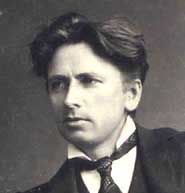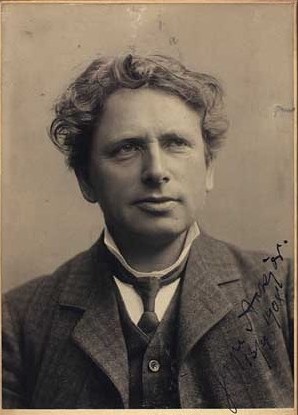Jeppe Aakjær facts for kids
Quick facts for kids
Jeppe Aakjær
|
|
|---|---|

Jeppe Aakjær
|
|
| Born | 10 September 1866 Fly, Jutland
|
| Died | 22 April 1930 (aged 63) Jenle
|
| Nationality | Danish |
| Known for | Poetry, writer |
|
Notable work
|
|
| Movement | Jutland Movement |
| Spouse(s) |
|
Jeppe Aakjær (born September 10, 1866 – died April 22, 1930) was a famous Danish poet and novelist. He was part of the 'Jutland Movement' in Danish literature. This means he wrote a lot about his home region, Jutland.
Aakjær was known for writing about the lives of poor people and describing what life was like in the countryside. His stories and poems often showed his concern for those who struggled.
Contents
Jeppe Aakjær's Early Life
Jeppe Aakjær was born on September 10, 1866, in Fly, a small village in Jutland, near Skive. He grew up in a big family with seven brothers and sisters. His father was a farmer, and Jeppe learned about farm life from a young age. This experience later inspired much of his writing.
His first jobs were as a herdsboy, looking after cattle. His father was a hard worker and supported the Venstre party, which was a liberal political group. This influenced Jeppe, and he also developed strong liberal ideas early on.
Jeppe's grandfather lived with the family on the farm. This arrangement, called aftægt, meant the parents gave up ownership of the farm in exchange for a place to live. This system sometimes caused problems. Jeppe later wrote about these issues in his books, like Paa Aftægt (In Retirement, 1907) and Vredens Børn (Children of Wrath, 1907).
Jeppe Aakjær's Education
Even though schooling was required in Denmark, many rural families, including Jeppe's, didn't always prioritize it. Jeppe spent more time working on the farm than at school at first.
Things changed in 1882 when a teacher named Niels Jakobsen started teaching in Fly. He convinced Jeppe's parents to send him to Staby to attend a Folk High School. In 1884, Jeppe went to Copenhagen and studied at Blaagaard's Teacher's College. He worked hard to become a teacher but left before finishing his degree.
Jeppe Aakjær's First Writings
Jeppe's writing journey began in 1883 while he was at school in Staby. He started sending stories to a journal called Skattegraveren (The Treasure Hunter). This journal focused on folklore, which Jeppe loved.
He had heard and remembered many stories, fables, and short pieces of literature from his childhood. Over several years, he collected and sent in hundreds of these. Most of them were published. His book Jydske Folkeminder VIII (Jutlandic Folklore VIII, 1886) included many of these early works.
Jeppe was skilled at telling folk tales and using the Jutlandic dialect in his writing. For example, his book Jens Langkniv (Jens Longknife, 1915) mixed folklore with historical events from 16th-century Danish witchcraft. He also showed this talent in his poetry, like in Bjergmands-snak (Mound-Dweller's Talk, 1949).
Jeppe Aakjær's Career
Early Career and Politics
When Jeppe was in Copenhagen for school, he loved the big city and its cultural opportunities. He was influenced by writers like Brandes and politicians like Jens Busk.
In 1886, he left Copenhagen and spent time on farms. He also started giving lectures at Folk High Schools. His talks often had a political message, aiming to inspire workers and farmers. Sometimes, the government thought his speeches were too strong, and he was jailed in Viborg when he was 20.
Aakjær was an outspoken socialist and joined the Social Democratic Party. He moved back to Copenhagen and worked as a proofreader and journalist. He also continued his studies in history at the University of Copenhagen.
In 1893, he married Marie Bregendahl, and they had a son named Svend. Later, in 1907, he married Nanna Krog, an artist. This second marriage was very happy, and they had two children, Esben and Solvejg.
Working for Newspapers
Jeppe's first job as a copy editor was at the newspaper Politiken. He became known for his article Missionen og dens Høvding (The Mission and its Chieftain, 1897). In this piece, he criticized certain religious movements. His boss, Edvard Brandes, was impressed and promoted him to journalist.
He later worked for other newspapers, including København and Provinspresse. At Provinspresse, he became a parliamentary correspondent. Although he found newspaper work took up a lot of his time, he kept a good relationship with Brandes, who often gave his books good reviews.
In 1899, Jeppe wrote his first major novel, Bondens Søn (The Peasant's Son). This book tells the story of a poor young man from Jutland named Jens who moves to Copenhagen. It explores how he deals with traditional beliefs and big-city freedoms.
Literary Success and Poetry
Jeppe Aakjær eventually partnered with the publishing firm Gyldendal. They published many of his books, including Fjandboer (Fjand Dwellers, 1901). He was careful to keep the rights to all his works, which was unusual at the time.
Around 1900, Jeppe spent a lot of time researching and writing a biography of Steen Steensen Blicher, another Danish writer. This work, Steen Steensen Blichers Livs-Tragedie (Steen Steensen Blicher's Life Tragedy, 1903-1904), was a major contribution to Danish literature.
In 1905 and 1906, he released two important poetry collections: Fri Felt (Open Field, 1905) and Rugens Sange og Andre Digte (Songs of the Rye and Other Poems, 1906). Songs of the Rye is often considered his best work. These poems focused on the beauty of rural life, inspired by his long walks and the rhythms of nature. He was also inspired by the Scottish poet Robert Burns, who wrote about rural life and dialect.
In 1906, Aakjær received the Anckerske Legat (Anckerske Scholarship), which allowed him to travel in Europe. He visited Scotland to connect with Robert Burns's work.
In 1907, Jeppe bought land and created his farm, Jenle. That same year, he wrote a successful play called Livet paa Hegnsgaard (Life at Hegns Farm). From 1910, Jeppe started the Jenlefest, an annual folk festival at his farm. These festivals became famous for bringing together politicians, writers, and farmers.
He continued to write poetry with themes of nature and rural life in collections like Vejr og Vind og Folkesind (Rain and Wind and Folkspirit, 1916) and Hjærtegræs og Ærenpris (Quaking Grass and Speedwell, 1921).
Jeppe Aakjær's Later Life and Death
Towards the end of his life, Jeppe focused on writing his memoirs and historical works. His memoirs filled four books, describing his childhood and memories from different periods of his life. He wrote many of these while he was sick.
Jeppe Aakjær passed away on April 22, 1930, from a heart attack.
The Jutland Movement
Jeppe Aakjær was an important member of the 'Jutland Movement'. This was not a formal group but a shared focus among writers on their native land, Jutland. Other writers in this group included Johannes V. Jensen and Jakob Knudsen. They all loved writing about the landscapes, people, and life in Jutland.
Jeppe often wondered why this movement didn't have a clear leader, unlike other literary groups. He felt that no one truly understood the deepest meaning of the Jutlandic literature.
Jeppe Aakjær's Notable Works
Aakjær's important novels, like Bondens Søn ("The Peasant's Son") (1899) and Vredens børn, et tyendes saga ("Children of Wrath: A Hired Man's Saga") (1904), show his strong commitment to social issues. Children of Wrath highlighted the difficult lives of rural workers. He also wrote Hvor Bønder bor ("Where Farmers Live") (1908) and Arbejdets Glæde ("The Joy of Work") (1914).
His book Jens Langkniv (1915) is about a Danish highwayman who becomes a fighter against the Germans in the 17th century. Many of his stories describe the tough lives of farm boys and workers, often with a strong, fighting spirit. He also wrote plays, such as Livet paa Hegnsgaard ("Life at the Hegn Farm") (1907), and a biography of Steen Steensen Blicher.
Today, Jeppe Aakjær is best known for his poetry. His famous poems include Fri felt ("Free Fields"; 1905), Rugens sange ("Songs of the Rye"; 1906), and Heimdal's Wanderings (1924). These poems show his love for nature and the harvest. Many of his poems were set to music by composers like Carl Nielsen because of their beautiful words.
In his songs, he wrote about the moors of his region, his childhood, and the simple life in the countryside. He often mixed harsh reality with a fresh love of nature and a touch of nostalgia. Some of his poems are even written in dialect. Among his most beloved poems are Jeg er Havren ("I am the Oats"), Jens Vejmand (a tribute to a tired road worker), Jutland, and Historiens Sang ("The Song of History"). As a poet, he also wrote powerful songs for the working class.
Aakjær is one of Denmark's most cherished poets of the 20th century. He followed in the footsteps of Blicher by writing about his region and using dialect. He was also inspired by Robert Burns, whose poem Auld lang syne he translated into the Jutlandic dialect. Jeppe Aakjær was an important writer who connected old rural culture with modern social ideas.
The Oats Poem
Aakjær's poem Havren (The Oats) was first published in his poetry collection "Vejr og Vind og Folkesind" in 1916. Like much of his poetry, it celebrates nature, which is a contrast to his more political writings. Havren has twelve verses, and a melody was composed for it in 1917 by Aksel Agerby. Today, usually only seven or eight of the original twelve verses are sung, and the song is often called Jeg er havren (I am the oats).
|
|
Images for kids
See also
 In Spanish: Jeppe Aakjær para niños
In Spanish: Jeppe Aakjær para niños



